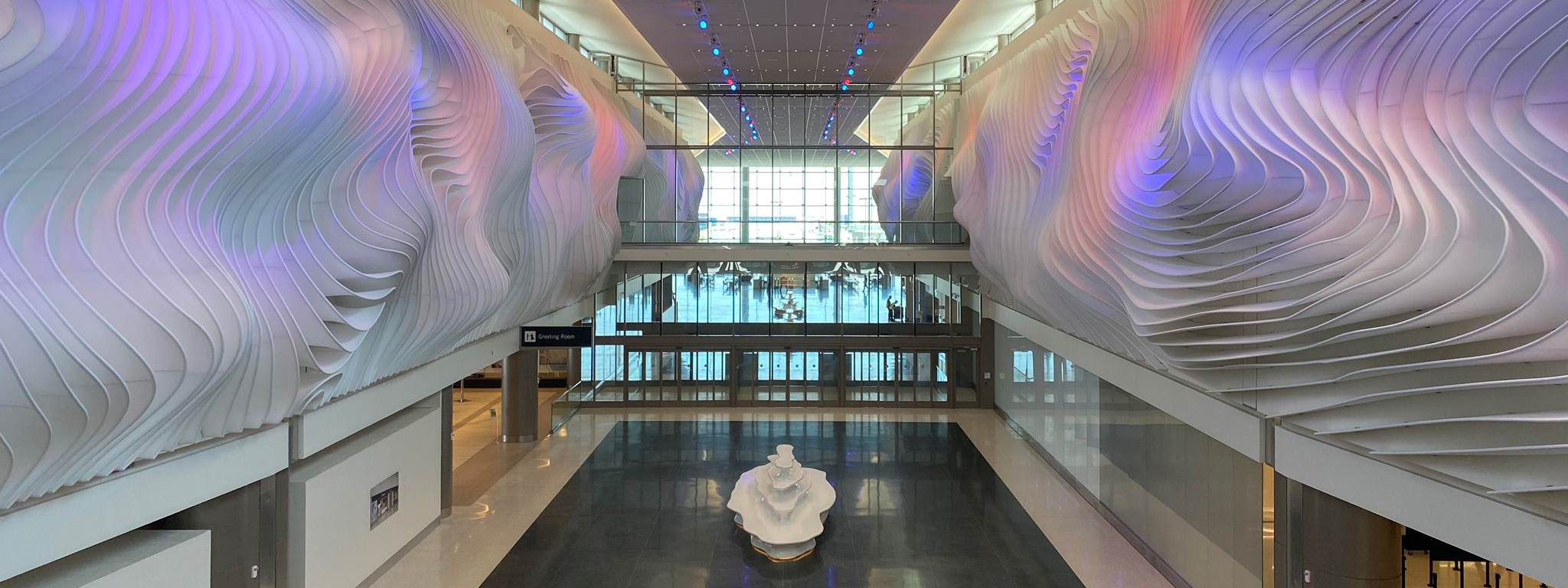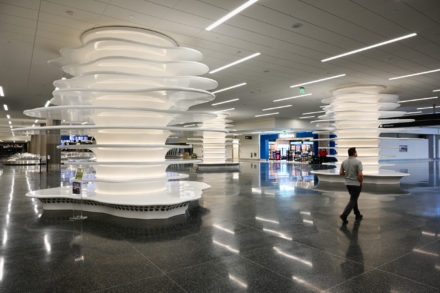
Courtesy of Salt Lake City Department of Airports
Turning Vision Into Reality at Salt Lake City International Airport
Six success strategies deliver phase one of the nation's newest hub airport
By Bill Wyatt, Executive Director | Salt Lake City Department of Airports
In September 2020, during a pandemic, the Salt Lake City Department of Airports opened phase one of a new generation of airport. The new Salt Lake City International Airport, or New SLC, features a beautiful new terminal, a parking garage with double the previous capacity and the initial portions of two new linear concourses. The concourses are currently connected via the mid-concourse tunnel. The tunnel is temporary until the permanent, central passenger tunnel, part of phase two, now underway, is completed.
The New SLC is the largest capital construction project in Utah’s history and the nation’s newest hub airport. Ready to accommodate 34 million passengers annually, the new facility replaces an existing terminal and five pier concourses, all built in the 1960s and ‘70s.
The successful completion of phase one of the SLCDA’s $4.1 billion Airport Redevelopment Project is directly linked to six strategies that helped turn our vision into a reality:
- Meet the moment
Large, transformative airport programs are like aircraft carriers. They don’t turn on a dime. Therefore, you must position the program to meet moments of opportunity when they arise. We’ve been able to do that by building out portions of the new airport’s infrastructure more than a decade before we needed them.One forward-positioning example happened in 2004. The SLCDA secured a Federal Aviation Administration grant to design and construct the shell of a west utility tunnel between the two concourses. The tunnel would not be needed for 15 years; however, the goal was to build it in advance and avoid disrupting aircraft traffic while the new concourses were constructed. Once the tunnel was constructed, it was immediately closed. We opened it officially in 2018, according to plan. It was an extremely forward-looking piece of planning that kept phase one disruption on the apron/airfield to a minimum. - Stay on plan
The cover page of SLC’s 1996 master plan looks much like what we’re building, which is amazing when you consider the difference between Salt Lake City in 1996 and the airline industry in 1996 and where we are today. Change has been constant. Yet, our program has enjoyed a continuity that has helped us stay true to our vision:- Delta Air Lines has been a part of the Airport Redevelopment Project from the beginning. SLC is critically important to them as an origin and destination market and a connecting market. Delta’s SLC hub gives the airline a strategic position to realize its vision as an international carrier.
- Delta recently extended its lease at SLC to strengthen the airport’s financial profile. By signing the lease extension, Delta has extended its commitment to SLC by 10 years. SLC is fortunate to have a hub carrier who understands our success is their success.
- The Salt Lake City community has experienced consistent growth and is fortunate to have a strong economy. For airports, that’s the secret sauce. A healthy economy drives development, and development creates demand for air travel.
- The SLCDA has enjoyed continuity in leadership. My engineering director participated in the 1996 master plan. He assembled the FAA grant request for the mid-concourse tunnel, the key to building the new concourses without significantly disrupting traffic.
- Assemble the right teams
The definition of “right” will be different for each airport. We created teams with specific skill sets and knowledge, such as project management, schedule maintenance, national airport expertise and local expertise. The project management team comprises private-sector employees who are experts in delivering large capital improvement programs. Within the project management team is a group responsible for maintaining the project schedule and looking for opportunities to accelerate it.The project team’s expertise in managing large capital programs and SLC’s internal oversight committee has been an effective combination. We (the airport) make the decisions, and they (the PM team) execute them. A program of this scale always will have challenges, but our working relationship with the project management team is strong. Whenever an issue arises, the group convenes to resolve it. If we don’t have the answer when we begin the meeting, we generally have a direction when we conclude it. The collaboration has been terrific.We also created two joint-venture contractor teams: one to focus on Concourse B and one to deliver the terminal and Concourse A. Each team has a contractor with extensive national and/or international airport experience and a contractor with extensive local experience. The national contractors each came to the project having excellent relationships with Delta Air Lines. The local firms know the trades, the local market and the traditions of this area. - Ask disruptive questions
The original game plan was to build half of Concourse B, half of Concourse A and all the landside terminal facilities in phase one while keeping two of three old concourses open to maintain needed gate counts and airline capacity requirements. In phase two, we would build the remainder of Concourse A for an additional 22 gates and the central portion of Concourse B for another eight gates.We planned to demolish the three old concourses one at a time over several years as new gates came online – and that presented a challenge. Constructing the new airport on top of the old airport, parts of which were in operation, would have required repeatedly closing one gate and opening another in a complex 25-phase process.When the pandemic hit, and air traffic all but evaporated, SLC went from serving up to 30,000 passengers a day to 1,500 a day. We met with the project management team and the airlines and asked a question that could significantly disrupt our game plan: “Did we need all of those open gates in the existing airport when passenger totals were so low? Or, could we demolish all three concourses at once, skip the 25 gate-changing phases and accelerate the second phase of this project by two years?”It took time to arrive at a conclusion, but the answer was, “Yes, we could do that.” Until the new Concourse A - East and additional Concourse B gates were available, we would operate remote aircraft hardstands. Once the existing airport was demolished, phase two was in control of its destiny.We also asked a second disruptive question during that time: “Should we take advantage of the downturn in business and build the central passenger tunnel now rather than wait?” The answer again was “yes” for the same reason we built the utility tunnel years earlier than planned. The central passenger tunnel would connect the main terminal with the Concourse B. The tunnel also is designed to extend to a future Concourse C and has the capacity for a people mover. If we didn’t construct the central passenger tunnel now and air travel returned, we would interrupt the traffic flow between the two parallel runways, making aircraft taxi time incredibly long. As a result, construction for the central tunnel is underway. It will open in 2023. - Have mechanisms to manage scope changes
In our case, that mechanism was the construction-manager at-risk delivery method, selected by my predecessor. CMAR is most effective when a project has significant scope changes, as ours has. For example, at the last minute, Delta asked to double the Sky Club space from 18,000 square feet to nearly 30,000 square feet.And, deep into the construction phase, we discovered the federal inspection station was too small to support the U.S. Customs and Border Protection’s new operations. We had to increase the size of the terminal’s footprint to accommodate a larger space. Currently, our challenge is determining how we might speed the completion of Concourse B to meet the demand for more space. In each instance, the CMAR has brought more brainpower and ingenuity to the table.Under design-build delivery, the scope can be more challenging to manage because it is not necessarily the owner’s design. The design-builder has designed it, and there is a risk of having the contractor build a facility that differs from the owner’s vision.Under CMAR, the SLCDA completed the airport design, and we hired a contractor to build it to our exact specifications. CMAR is giving the SLCDA what we wanted and planned for, a new, more efficient global airport that will offer an exceptional travel experience. - Push through adversity
Two and a half years ago, we circled Sept. 15, 2020, as the opening day for phase one of the Airport Redevelopment Project. Working backward from that date, we considered the scope of work in front of us, the project’s pace and our experience to date. The timeline seemed reasonable and doable.In February 2020, just as the project was in the final stretch with 1,800 to 2,000 tradespeople on-site daily, the pandemic hit. In early March, we convened the general contractors, the project management team and the county health department and instituted effective and immediate health and safety protocols.We mandated mask-wearing inside the building, conducted temperature checks and enforced social distancing with signage and an increased number of safety officers. We kept the workforce safe and earning their salaries. And the project stayed on schedule. We never shut down, nor did we change our opening date.Oddly, the pandemic eased the task of opening a new airport. Unlocking the front door on Day 1 to 30,000 people, including 20,000 connecting passengers, would have been challenging. The pandemic, however, provided an opportunity for a “soft opening.” Low passenger volumes gave us time to work out the kinks and provide proper staff training.Of the six strategies we used to successfully deliver phase one of the Airport Redevelopment Project, pushing through adversity has been pivotal in turning our vision into a reality. Today, Salt Lake City has a stunningly beautiful airport terminal complex that will serve and grow with the region for decades to come.
On trend
"A result of airlines’ and passengers’ increased use of technology, there is less space at the front of the new terminal than the old terminal. Further, the airport is expandable. More gates could be added to the Concourse B and a third, parallel concourse is planned for the future

The New SLC
- A two-level roadway with elevated departures roadway
- A parking garage with 3,600 stalls and a camera-based sensor system that uses lights to indicate open spots
- 56 electronic vehicle charging stations
- The Gateway Building, housing car rental counters and quick-check ticket countersf
- 16 security screening lanes with automatic return bins for touchless processing
- 45 concessions with street pricing
- Electronic outlets at each seat and in open-seating areas
- 7 miles of luggage conveyor belts to accommodate oversized items
- Aircraft gates that employ the SAFEGATE Aircraft Docking System for automated aircraft parking
- 24 restrooms with private lactation rooms
- A large greeting room to wait for and meet arriving passengers once physical distancing measures are lifted
- Large-scale art installations to represent Utah’s natural beauty and provide a sense of place

ABOUT THE AUTHOR
Bill Wyatt is the Executive Director of the Salt Lake City Department of Airports, which operates Salt Lake City International Airport and two reliever airports, South Valley Regional Airport and Tooele Valley Airport. Previously, Wyatt spent 16 years as the Executive Director of the Port of Portland, where he oversaw four marine terminals, two general aviation airports and Portland International Airport. Contact him at [email protected].
